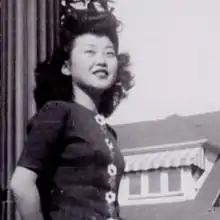Esther Takei Nishio | |
|---|---|
 | |
| Born | Esther Kazue Takei February 15, 1925 Los Angeles, California |
| Died | October 1, 2019 (aged 94) Pasadena, California |
| Nationality | American |
| Occupation | Secretary |
| Known for | Japanese-American internee; first internee enrolled in a California college during World War II |
Esther Takei Nishio (February 15, 1925 – October 1, 2019) was an American woman from California, incarcerated at the Granada War Relocation Center in Colorado during World War II. She was the first Japanese-American student to enroll in a California university after returning from camp, in 1944, when she was chosen as a test case for resettlement.
Early life
Esther Kazue Takei was born in Los Angeles, California, the daughter of Shigehisa "Harry" Takei and Ninoe Takei.[1] She was raised in Venice Beach, where her Japanese-born parents ran concession stands along the pier.[2][3][4] At age 6, she was chosen to be a "mascot" for the Japanese team at the 1932 Summer Olympics held in Los Angeles.[5]
World War II
As a teenager,[6] a senior at Venice High School,[7] she was incarcerated with her family at Granada War Relocation Center in Granada, Colorado, from 1942 to 1944 following the signing of Executive Order 9066. "I thought, well, I guess, as a good American citizen, we have to do what the government wants us to do," she recalled many years later.[2] She worked as a dental assistant in the internment camp, and drew a weekly cartoon, "Ama-Chan", for the camp newspaper, the Granada Pioneer.[4][8] She also briefly worked as a live-in servant for a family in Boulder, Colorado.[3]
In 1944, she was allowed to return to California and enroll in Pasadena Junior College, as a "test case" for Japanese-American resettlement after the war.[4][9] During her time as a student, she lived with the family of Hugh Anderson, a Quaker accountant in Altadena.[10] Her enrollment was greeted with threats and harassment from anti-Japanese nativists in the area; sympathetic students and others volunteered to walk with her on campus, for her safety.[2] The War Relocation Authority's director, Dillon S. Myer, stood by the decision to allow Takei's enrollment.[11] "Her ultimately successful resettlement helped pave the way for the mass return of Japanese Americans to the West Coast beginning in January 1945," noted one profile.[3]
Takei left college without graduating, to help her parents re-establish themselves in Los Angeles; in 2010 Pasadena City College presented her with an honorary degree.[3]
After the war
Nishio worked as a secretary. Her parents moved to Japan in 1958. She testified before the 1981 Commission on Wartime Relocation and Internment of Civilians. In 1999 she gave an oral history interview to the Japanese American National Museum.[2] She was named California Woman of the Year in 2012.[4] That year, she spoke on a panel at the first Fred Korematsu Day event in Pasadena.[12]
Esther Takei married a fellow Japanese-American internee, Shigeto Nishio, in 1947; they had a son, John. She died in 2019, aged 94 years, in Pasadena, California.[2] There is a box of her papers, including letters, photographs, and her 1944 identification badge, at the Japanese American National Museum in Los Angeles.[13]
References
- ↑ "Obituary: Ninoe Takei". The Los Angeles Times. August 16, 1996. p. 106. Retrieved November 30, 2019 – via Newspapers.com.
- 1 2 3 4 5 Mozingo, Joe (2019-11-30). "Column One: She was a test case for resettling detainees of Japanese descent — and unaware of the risk". Los Angeles Times. Retrieved 2019-12-01.
- 1 2 3 4 Niiya, Brian. "Esther Takei Nishio". Densho Encyclopedia. Retrieved 2019-12-01.
- 1 2 3 4 "OBITUARY: Esther Nishio, 94; First Nisei Student to Return to West Coast". Rafu Shimpo. 25 October 2019. Retrieved 2019-12-01.
- ↑ "Typical Japanese Girl". The North Adams Transcript. January 19, 1932. p. 6. Retrieved November 30, 2019 – via Newspapers.com.
- ↑ Tong, Benson (2004). "Race, Culture, and Citizenship among Japanese American Children and Adolescents during the Internment Era". Journal of American Ethnic History. 23 (3): 3–40. doi:10.2307/27501456. ISSN 0278-5927. JSTOR 27501456. S2CID 254495696.
- ↑ Miyake, Perry Jr. "Venice Japanese Community Center". Inside the VJCC. Retrieved 2019-12-01.
- ↑ ""Ama-Chan," The Amache Pinup". No No Boy. Retrieved 2019-12-01.
- ↑ Matsumoto, Valerie J. (2016-12-15). City Girls: The Nisei Social World in Los Angeles, 1920-1950. Oxford University Press. p. 145. ISBN 978-0-19-065520-4.
- ↑ "First Nisei Returns Here". The Los Angeles Times. September 13, 1944. p. 13. Retrieved November 30, 2019 – via Newspapers.com.
- ↑ "Pasadena Hears W. R. A. Director Defend Policies". The Los Angeles Times. September 30, 1944. p. 16. Retrieved November 30, 2019 – via Newspapers.com.
- ↑ "First Fred Korematsu Day Event in Pasadena". Rafu Shimpo. January 19, 2012. Retrieved 2019-12-01.
- ↑ "Esther Takei Nishio Papers". Japanese American National Museum. Retrieved 2019-12-01.
External links
- Videos of an oral history interview Esther Takei Nishio gave to Densho in 2011, online at Internet Archive.
- Video of Esther Takei Nishio telling her story, by Blake Tamaki, for the California Nisei College Diploma Project.
- Another video interview of Esther Takei Nishio, conducted by the Institute for Asian American Studies at UMass Boston.